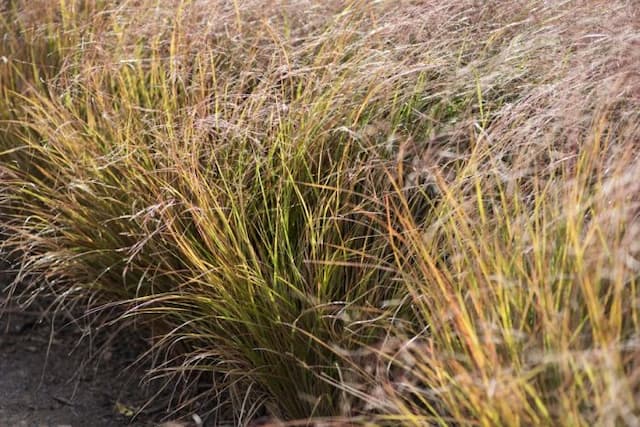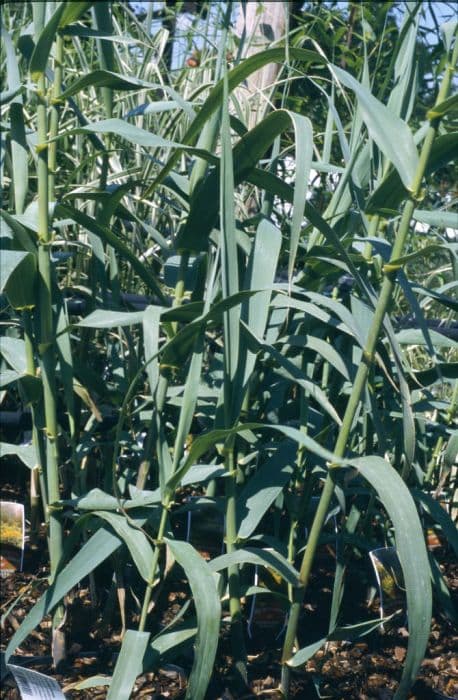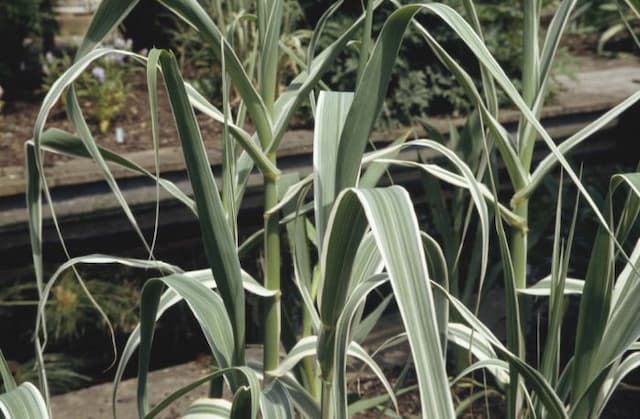Umbrella Bamboo Fargesia murielae

ABOUT
The plant commonly known as Umbrella Bamboo features a graceful, clump-forming growth habit with an attractive green hue. Its culms, or stems, exhibit a vibrant green color that transitions to yellow as they mature, lending a beautiful contrast to the dense foliage. Each stem is complemented by nodes which are spaced intermittently, giving it a segmented look characteristic of bamboo. The leaves are long and narrow, with a pointed tip and a lush green color, contributing to a dense and bushy appearance. As a deciduous plant in some climates, the foliage may turn to a golden hue before shedding. Umbrella Bamboo is known for its hardiness and ability to create a serene aesthetic, making it a popular choice for creating natural privacy screens or as a feature in oriental-themed gardens. The plant's foliage rustles delightfully in the breeze, adding a sense of movement and tranquil sound to the garden landscape. Overall, the appearance of the Umbrella Bamboo is one of elegance and tranquility, with strong stems cloaked in vibrant green foliage, making it an attractive addition to a wide array of garden designs.
About this plant
 Names
NamesFamily
Poaceae
Synonyms
Umbrella Bamboo, Muriel's Bamboo
Common names
Arundinaria murielae, Thamnocalamus spathiflorus var. murielae, Yushania murielae.
 Toxicity
ToxicityTo humans
Umbrella Bamboo is not known to be toxic to humans. There are no significant symptoms of poisoning associated with this plant, as it is not considered harmful if ingested.
To pets
Umbrella Bamboo is also not known to be toxic to pets. There are no reports of significant toxicity or symptoms of poisoning in animals resulting from ingesting this plant. It is generally considered safe for pets.
 Characteristics
CharacteristicsLife cycle
Perennials
Foliage type
Evergreen
Color of leaves
Green
Height
12-15 feet (3.7-4.6 meters)
Spread
4-6 feet (1.2-1.8 meters)
Plant type
Bamboo
Hardiness zones
5-9
Native area
China
Benefits
 General Benefits
General Benefits- Visual Appeal: Fargesia murielae, commonly known as Umbrella Bamboo, offers a lush and elegant look with its dense foliage and arching canes.
- Privacy Screen: Due to its dense growth habit, it can serve as an effective privacy screen, blocking unwanted views and nosy neighbours.
- Noise Reduction: The thick clustering of canes and leaves can help dampen noise, making it ideal for urban gardens or areas near roads.
- Soil Erosion Control: The root system of Umbrella Bamboo helps to stabilize soil, reducing erosion on slopes and in areas prone to soil loss.
- Wildlife Habitat: Provides shelter and food for various species, such as birds and small mammals, enhancing local biodiversity.
- Shade Provider: Can be utilized to create shaded areas in the garden, helping to protect understorey plants and providing relief from the sun.
- Low Maintenance: Umbrella Bamboo is generally low maintenance, requiring only basic care once established, making it suitable for a range of gardeners.
- Adaptable Growth: It can be grown in a variety of conditions and is relatively adaptable to different soil types and climates within its growing zones.
- Non-Invasive: Unlike some bamboo species, Fargesia murielae is a clumping bamboo and is less likely to spread uncontrollably, making it a good choice for residential gardens.
 Medical Properties
Medical PropertiesThis plant is not used for medical purposes.
 Air-purifying Qualities
Air-purifying QualitiesThis plant is not specifically known for air purifying qualities.
 Other Uses
Other Uses- Furniture Material: Fargesia murielae, commonly known as Umbrella Bamboo, can be used to make lightweight and durable bamboo furniture.
- Garden Fencing: The poles from Umbrella Bamboo are sturdy and can be woven together to create a natural-looking and robust garden fence.
- Ornamental Features: Due to its aesthetically pleasing form and color, it can be used as a focal point in garden designs and landscapes.
- Privacy Screens: The dense growth pattern of Umbrella Bamboo makes it ideal for creating living privacy screens in urban settings.
- Sound Barrier: Planted densely along roads or noisy areas, Umbrella Bamboo can act as an effective sound barrier reducing noise pollution.
- Windbreaks: The plant's resilience to wind makes it suitable for protecting more vulnerable plants in the garden by acting as a windbreak.
- Erosion Control: The root system of Umbrella Bamboo helps stabilize soil on slopes, thus preventing soil erosion.
- Edible Shoots: The young shoots of Umbrella Bamboo are edible and can be used in various culinary dishes, though they are not as popular as some other bamboo species.
- Handicrafts: The canes are used for making musical instruments, crafting unique household items, and other artisanal bamboo products.
- Live Feed for Animals: Umbrella Bamboo can be used as a food source for some species of livestock and zoo animals, like pandas and elephants.
Interesting Facts
 Feng Shui
Feng ShuiThe Umbrella Bamboo is not used in Feng Shui practice.
 Zodiac Sign Compitability
Zodiac Sign CompitabilityThe Umbrella Bamboo is not used in astrology practice.
 Plant Symbolism
Plant Symbolism- Resilience: Fargesia murielae, commonly known as Umbrella Bamboo, is admired for its hardiness and ability to thrive in various conditions, symbolizing the capacity to overcome adversity.
- Growth and Flexibility: Like many bamboo species, Umbrella Bamboo grows rapidly and is flexible in the wind, representing adaptability and continuous personal growth.
- Privacy and Protection: The dense growth habit of Umbrella Bamboo makes it an excellent choice for creating natural barriers, symbolizing the need for privacy and a secure personal space.
- Peace and Tranquility: The gentle rustling of the leaves in the breeze evokes a sense of calm and peace, making it a symbol for tranquility and relaxation.
 Water
WaterUmbrella Bamboo should be watered deeply and thoroughly to ensure that the soil is evenly moist. During the growing season, it typically requires watering once a week, with about 1.5 gallons per watering session for an established plant. In hotter, drier conditions, you may need to water twice a week. Decrease the frequency to every other week during the cooler months, or when rainfall is sufficient to maintain soil moisture. Always check the top few inches of soil for dryness before watering.
 Light
LightUmbrella Bamboo thrives in partial shade to full sun. The ideal spot for the plant is one where it receives morning sunlight and afternoon shade or is protected by a light canopy of taller trees. Avoid placing it in a location with prolonged exposure to strong afternoon sun to prevent leaf scorch.
 Temperature
TemperatureUmbrella Bamboo prefers temperate climates with temperatures ranging from 5°F to 95°F, although it can withstand brief periods outside this range. The ideal temperature for robust growth is between 59°F and 77°F. It's cold hardy and can endure winter temperatures down to -5°F, making it suitable for many temperate regions.
 Pruning
PruningPruning Umbrella Bamboo is done primarily to remove dead or damaged canes and to maintain the desired shape and size. Prune in the late winter or early spring before new growth begins. Thinning out old canes every few years encourages new growth and improves air circulation, helping to maintain a healthy and attractive plant.
 Cleaning
CleaningAs needed
 Soil
SoilFor Umbrella Bamboo (Fargesia murielae), create a rich, loamy soil mix with good drainage, incorporating organic matter like compost. The best soil pH is slightly acidic to neutral, ranging from 5.5 to 7.0.
 Repotting
RepottingUmbrella Bamboo should be repotted every two to three years to ensure sufficient space for root growth and to replenish the soil.
 Humidity & Misting
Humidity & MistingUmbrella Bamboo flourishes in moderate to high humidity levels, ideally around 40-60%.
 Suitable locations
Suitable locationsIndoor
Provide bright, indirect light and protect from drafts.
Outdoor
Plant in part shade, protect from strong winds.
Hardiness zone
5-9 USDA
 Life cycle
Life cycleThe life of Fargesia murielae, commonly known as Umbrella Bamboo, begins with seed germination, where it emerges as a seedling and starts to establish its root system. As it grows, it enters the vegetative stage, developing tall canes and delicate, feathery leaves that contribute to its characteristic clumping habit. Over a few years, it achieves maturity and can reach up to 4-5 meters in height. Umbrella Bamboo then enters its flowering stage, which is quite rare and can occur every 80-100 years, with flowering often signaling the end of the plant's life cycle as many clumps die after flowering. However, during the flowering period, seeds are produced which can fall to the ground and give rise to new seedlings, continuing the species' cycle. Some clumps may survive and regenerate new shoots, initiating a new vegetative phase.
 Propogation
PropogationPropogation time
Spring-early summer
The most popular method of propagating the Fargesia murielae, commonly known as Umbrella Bamboo, is through division. This is ideally done in the spring as the bamboo begins to grow actively. To propagate by division, one should carefully dig up a mature clump and use a sharp spade or a saw to divide it into smaller sections, each containing several growing culms and a portion of the root system. It is important to keep the divisions moist and plant them immediately at the same depth they were growing previously. The new divisions should be watered thoroughly after planting to help establish them. This method allows the bamboo to recover quickly and continue growing with minimal stress.









